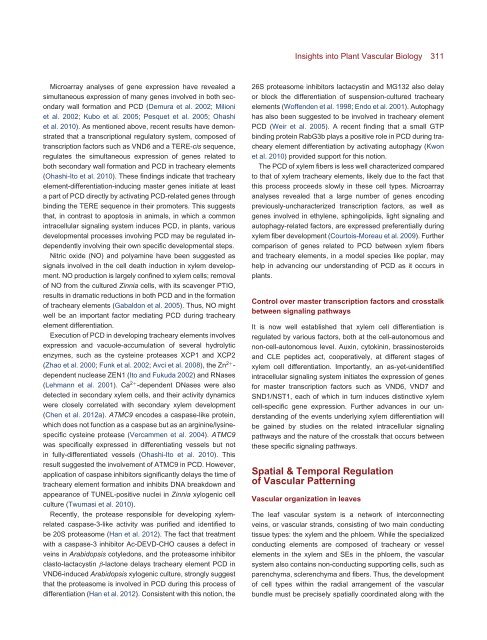The Plant Vascular System: Evolution, Development and FunctionsF
The Plant Vascular System: Evolution, Development and FunctionsF
The Plant Vascular System: Evolution, Development and FunctionsF
Create successful ePaper yourself
Turn your PDF publications into a flip-book with our unique Google optimized e-Paper software.
Microarray analyses of gene expression have revealed a<br />
simultaneous expression of many genes involved in both secondary<br />
wall formation <strong>and</strong> PCD (Demura et al. 2002; Milioni<br />
et al. 2002; Kubo et al. 2005; Pesquet et al. 2005; Ohashi<br />
et al. 2010). As mentioned above, recent results have demonstrated<br />
that a transcriptional regulatory system, composed of<br />
transcription factors such as VND6 <strong>and</strong> a TERE-cis sequence,<br />
regulates the simultaneous expression of genes related to<br />
both secondary wall formation <strong>and</strong> PCD in tracheary elements<br />
(Ohashi-Ito et al. 2010). <strong>The</strong>se findings indicate that tracheary<br />
element-differentiation-inducing master genes initiate at least<br />
a part of PCD directly by activating PCD-related genes through<br />
binding the TERE sequence in their promoters. This suggests<br />
that, in contrast to apoptosis in animals, in which a common<br />
intracellular signaling system induces PCD, in plants, various<br />
developmental processes involving PCD may be regulated independently<br />
involving their own specific developmental steps.<br />
Nitric oxide (NO) <strong>and</strong> polyamine have been suggested as<br />
signals involved in the cell death induction in xylem development.<br />
NO production is largely confined to xylem cells; removal<br />
of NO from the cultured Zinnia cells, with its scavenger PTIO,<br />
results in dramatic reductions in both PCD <strong>and</strong> in the formation<br />
of tracheary elements (Gabaldon et al. 2005). Thus, NO might<br />
well be an important factor mediating PCD during tracheary<br />
element differentiation.<br />
Execution of PCD in developing tracheary elements involves<br />
expression <strong>and</strong> vacuole-accumulation of several hydrolytic<br />
enzymes, such as the cysteine proteases XCP1 <strong>and</strong> XCP2<br />
(Zhao et al. 2000; Funk et al. 2002; Avci et al. 2008), the Zn 2+ -<br />
dependent nuclease ZEN1 (Ito <strong>and</strong> Fukuda 2002) <strong>and</strong> RNases<br />
(Lehmann et al. 2001). Ca 2+ -dependent DNases were also<br />
detected in secondary xylem cells, <strong>and</strong> their activity dynamics<br />
were closely correlated with secondary xylem development<br />
(Chen et al. 2012a). ATMC9 encodes a caspase-like protein,<br />
which does not function as a caspase but as an arginine/lysinespecific<br />
cysteine protease (Vercammen et al. 2004). ATMC9<br />
was specifically expressed in differentiating vessels but not<br />
in fully-differentiated vessels (Ohashi-Ito et al. 2010). This<br />
result suggested the involvement of ATMC9 in PCD. However,<br />
application of caspase inhibitors significantly delays the time of<br />
tracheary element formation <strong>and</strong> inhibits DNA breakdown <strong>and</strong><br />
appearance of TUNEL-positive nuclei in Zinnia xylogenic cell<br />
culture (Twumasi et al. 2010).<br />
Recently, the protease responsible for developing xylemrelated<br />
caspase-3-like activity was purified <strong>and</strong> identified to<br />
be 20S proteasome (Han et al. 2012). <strong>The</strong> fact that treatment<br />
with a caspase-3 inhibitor Ac-DEVD-CHO causes a defect in<br />
veins in Arabidopsis cotyledons, <strong>and</strong> the proteasome inhibitor<br />
clasto-lactacystin β-lactone delays tracheary element PCD in<br />
VND6-induced Arabidopsis xylogenic culture, strongly suggest<br />
that the proteasome is involved in PCD during this process of<br />
differentiation (Han et al. 2012). Consistent with this notion, the<br />
Insights into <strong>Plant</strong> <strong>Vascular</strong> Biology 311<br />
26S proteasome inhibitors lactacystin <strong>and</strong> MG132 also delay<br />
or block the differentiation of suspension-cultured tracheary<br />
elements (Woffenden et al. 1998; Endo et al. 2001). Autophagy<br />
has also been suggested to be involved in tracheary element<br />
PCD (Weir et al. 2005). A recent finding that a small GTP<br />
binding protein RabG3b plays a positive role in PCD during tracheary<br />
element differentiation by activating autophagy (Kwon<br />
et al. 2010) provided support for this notion.<br />
<strong>The</strong> PCD of xylem fibers is less well characterized compared<br />
to that of xylem tracheary elements, likely due to the fact that<br />
this process proceeds slowly in these cell types. Microarray<br />
analyses revealed that a large number of genes encoding<br />
previously-uncharacterized transcription factors, as well as<br />
genes involved in ethylene, sphingolipids, light signaling <strong>and</strong><br />
autophagy-related factors, are expressed preferentially during<br />
xylem fiber development (Courtois-Moreau et al. 2009). Further<br />
comparison of genes related to PCD between xylem fibers<br />
<strong>and</strong> tracheary elements, in a model species like poplar, may<br />
help in advancing our underst<strong>and</strong>ing of PCD as it occurs in<br />
plants.<br />
Control over master transcription factors <strong>and</strong> crosstalk<br />
between signaling pathways<br />
It is now well established that xylem cell differentiation is<br />
regulated by various factors, both at the cell-autonomous <strong>and</strong><br />
non-cell-autonomous level. Auxin, cytokinin, brassinosteroids<br />
<strong>and</strong> CLE peptides act, cooperatively, at different stages of<br />
xylem cell differentiation. Importantly, an as-yet-unidentified<br />
intracellular signaling system initiates the expression of genes<br />
for master transcription factors such as VND6, VND7 <strong>and</strong><br />
SND1/NST1, each of which in turn induces distinctive xylem<br />
cell-specific gene expression. Further advances in our underst<strong>and</strong>ing<br />
of the events underlying xylem differentiation will<br />
be gained by studies on the related intracellular signaling<br />
pathways <strong>and</strong> the nature of the crosstalk that occurs between<br />
these specific signaling pathways.<br />
Spatial & Temporal Regulation<br />
of <strong>Vascular</strong> Patterning<br />
<strong>Vascular</strong> organization in leaves<br />
<strong>The</strong> leaf vascular system is a network of interconnecting<br />
veins, or vascular str<strong>and</strong>s, consisting of two main conducting<br />
tissue types: the xylem <strong>and</strong> the phloem. While the specialized<br />
conducting elements are composed of tracheary or vessel<br />
elements in the xylem <strong>and</strong> SEs in the phloem, the vascular<br />
system also contains non-conducting supporting cells, such as<br />
parenchyma, sclerenchyma <strong>and</strong> fibers. Thus, the development<br />
of cell types within the radial arrangement of the vascular<br />
bundle must be precisely spatially coordinated along with the
















